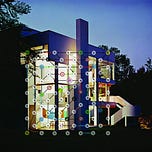“In the midst of chaos, there is also opportunity.”
— Sun Tzu, from The Art of War
The Random/Strategic Divide
Random versus strategic gameplay are two extremes in board games. Chess is strategic, Chutes and Ladders is random. Games can be defined by where they fall on this divide.
Mature gamers disdain random while immature gamers are entertained by it, but there’s more to it than maturity. Strategic games are puzzles assumed to have a hidden solution. Random games don’t have a hidden solution because they provide no control.
Games are ultimately stories, and good stories need a goal, a means, and uncertainty. Without all three the story falls flat. Too many games work only on parts of this equation and fail to engage their synergistic effect. The best games, like the best stories, are strong in all three.
There is uncertainty in a strategic game between evenly matched players but the uncertainty fades when one player is more skilled than another. At the same time complete uncertainty undermines the story if it overwhelms control. A jigsaw puzzle would have no appeal if it was just a grey field with no picture of what the whole looked like.
Random games have uncertainty built in, and random events can be made uncertain in equal measure for all players so that no one has an advantage. Randomness can add tension while still keeping the balance. For this reason we find random elements everywhere in games.
What we find in most games is biased randomness, a mix of strategic advantage and random elements. This weighted uncertainty is a kind of handicap for the more thoughtful players, and a source of opportunity for the less thoughtful ones.
It puzzles me why people find complete randomness entertaining, so entertaining that they’ll pay to play lotteries they’re certain to lose on average. These games have no story aside from the illusion of luck that you create yourself. It goes to show that part of games is something that goes on in our minds.
Another Direction
Complexity is the partner of randomness. It provides a third direction. Rather than thinking of games on a spectrum of the two extremes of random or strategic, complexity offers a third dimension.
Complexity can overwhelm strategy and obscure randomness. The complexity of wartime battle simulations support gameplay at any scale and strategy of almost any kind. Such games may have no randomness but still feel completely unpredictable.
Simplicity can reveal strategy and make randomness seem trivial. Scrabble is a memory game based on letters you draw at random. Your focus is entirely on spelling and recognizing patterns on the board. For most players, predicting the odds of drawing letters is not important.
Tic Tac Toe has strategy without complexity, while Pick Up Sticks has complexity with little strategy. The only strategy in Pick Up Sticks is to work from the top down.
Playing with multiple dice becomes complex as the combinations of several dice make for complicated probabilities. In contrast, games that rely on a spinner or other generators of a flat probability supply only white noise. White noise helps you fall asleep, it does not engage your mind.
However, combining white noise with asymmetric outcomes generates complexity. This is the mechanism of asymmetric battle games that use dice to decide outcomes. It’s also how a game like Twister creates a story through the use of a spinner that has no story. Randomness combined with complexity creates structure.
My Latest Game
My game Clients Versus Architects combines entirely strategic game play with the weighted randomness of dealt hands of cards. The randomness of cards is complex as the statistics of what cards are drawn changes as cards are dealt and revealed. It is only the dealing of a well shuffled deck that is random. As long as there are different cards in the deck the deck is structured.
This game combines the complexity of the deck, which is the only source of complexity in traditional card games, with even greater complexity in the boards. The game is an exercise in uncovering and controlling order in a disruptive environment.
The odds built into traditional card decks appear straightforward but aren’t. Compare Solitaire, where the odds are fairly obvious, to Poker, where they are not. In Clients Versus Architects each player is both a client, who earns money, and an architect, who spends their client’s money. You win by spending the most money, but you can’t spend more than your client can earn.
In the context of a story, this complicates the goal. It creates tension without conflict. The conflict arises in the competition with other players.
Games typically create conflict through battle or ambush, but I wanted something more indirect. In Clients Versus Architects players modify each other's boards, changing obstacles into opportunities—and vice versa—using cards that are played as in poker.
Clients Versus Architects is mostly a maze in which each player creates a better path for themself while making a worse path for everyone else. Something like what you’d get if you added a random element to chess.
An attack is only as interesting as the outcome is uncertain. In chess the uncertainty lies in how one defends one’s pieces. In Clients Versus Architects the uncertainty lies in how one defends one’s board.
Complexity
I’m interested in how structures grow. People have created 3-dimensional chess boards, or four-player chess games. This kind of scaling easily becomes overwhelming because it adds too much complexity. Games become uninteresting when the players lose control of the story. Still, there is something appealing about being on the edge of control.
Complexity is a part of game design that’s rarely managed well. It’s easy to make a game too complicated. We see this in 200-page instruction manuals.
The best forms of complexity allow for fine adjustment. Things like the size of the board, the number of different tokens, and the size of each decision tree. Complexity can easily grow as the game progresses. Ideally, the arc of complexity has exposition, consolidation, and resolution phases that follow the story.
In the best games players know where they stand and can see the options before them. In games with simple rules and complex configurations, like chess, even beginners can play with confidence. The challenge isn’t in understanding the rules, it’s in understanding their consequences. The complexity of these games lies in the future, not the present, and the better player sees farther ahead.
In Clients Versus Architects I offer a clear future visible to a strategic thinker. I then allow players to bend the future by changing the playing board. With just enough uncertainty everyone’s advantages are fragile, their strategies easily upset, and the outcome is uncertain.
My Kickstarter campaign will launch in May. Join my mailing list for more insights, announcements, and offers: https://clientsversusarchitects.com




